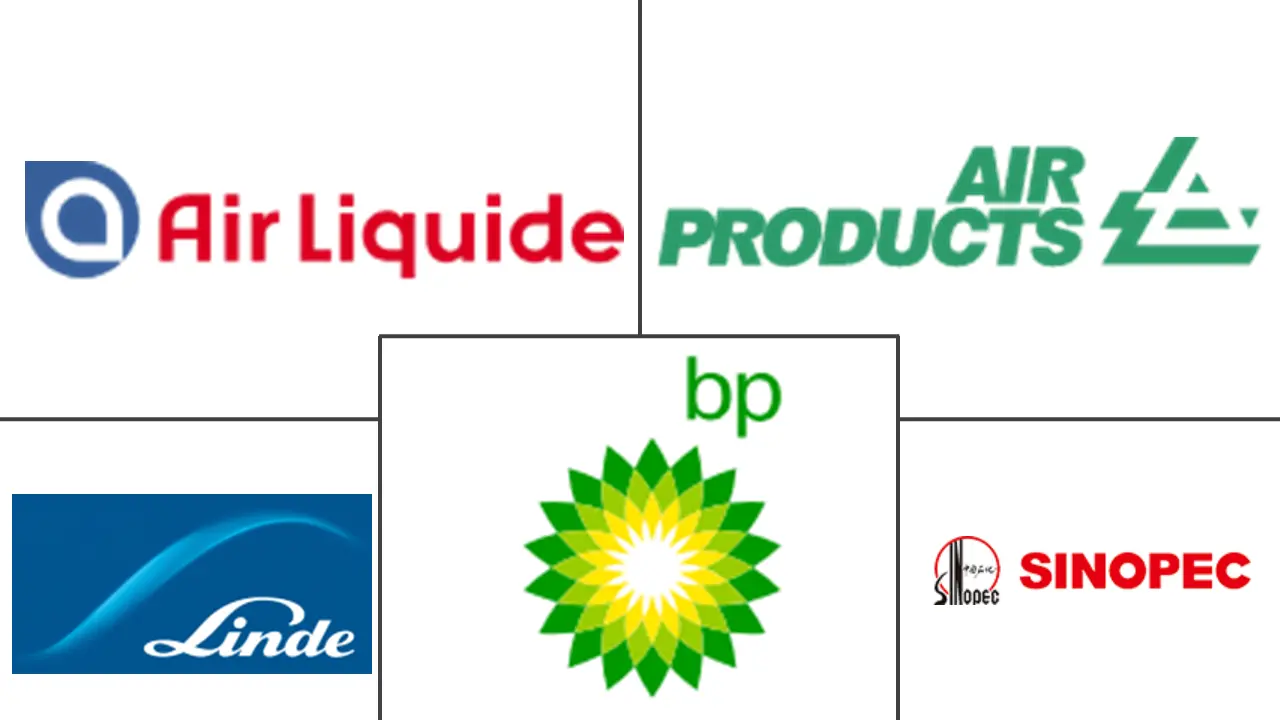Green Hydrogen Market Size and Share
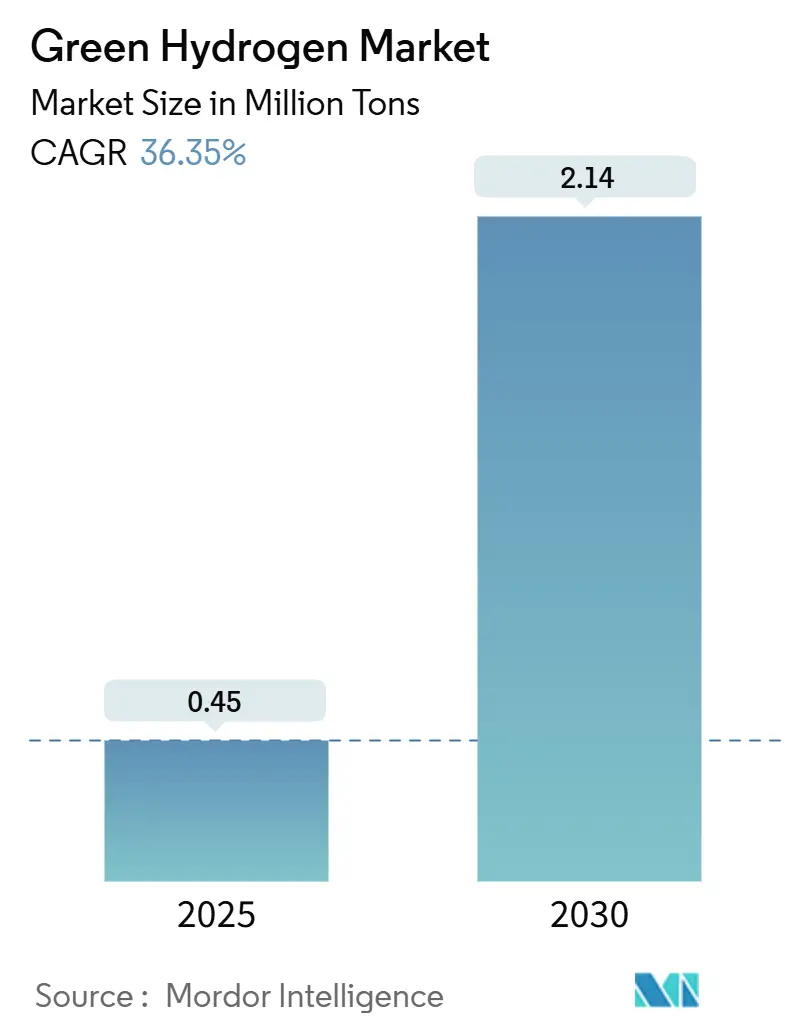
Green Hydrogen Market Analysis by Mordor Intelligence
The Green Hydrogen Market size is estimated at 0.45 Million tons in 2025, and is expected to reach 2.14 Million tons by 2030, at a CAGR of 36.35% during the forecast period (2025-2030). Rapid cost declines in renewable electricity, increasingly stringent decarbonization policies, and accelerating electrolyzer innovation are reinforcing demand across hard-to-abate sectors. Asia Pacific anchors global capacity expansion, while Europe races ahead on policy-backed deployment targets that reward low-carbon production. Alkaline systems retain cost leadership; however, Proton Exchange Membrane (PEM) units are carving out a share in projects tied to variable solar and wind assets. Refiners remain the largest buyers, yet chemical producers moving into green ammonia and methanol are changing long-term consumption patterns, prompting record electrolyzer orders and multi-GW investment pledges that will shape the next wave of supply chain growth in the green hydrogen market.
Key Report Takeaways
- By technology, alkaline electrolysis led with 55% of the green hydrogen market share in 2025, whereas PEM is projected to post the highest CAGR of 42.30% through 2030.
- By end-user industry, the refining segment accounted for 35% of the green hydrogen market size in 2025, while chemicals is forecast to expand at a 47.18% CAGR between 2025-2030.
- By geography, Asia Pacific commanded 48% revenue share of the green hydrogen market in 2025; Europe represents the fastest-growing region with a 54.17% CAGR to 2030.
Global Green Hydrogen Market Trends and Insights
Drivers Impact Analysis
| Driver | (~) % Impact on CAGR Forecast | Geographic Relevance | Impact Timeline |
|---|---|---|---|
| Declining Levelized Cost of Renewable Power in High-Irradiance Regions | +8.2% | MENA, Australia, Southern Europe, Latin America | Medium term (2-4 years) |
| Industrial Decarbonization Mandates in European Steel & Fertilizer Production | +7.5% | Europe, with spillover to North America | Medium term (2-4 years) |
| Realizing the Potential in the Chemical Industry | +6.4% | Global, with concentration in Asia Pacific | Long term (≥ 4 years) |
| Growing Environmental Concerns Regarding Carbon Emissions | +5.3% | Global | Long term (≥ 4 years) |
| Maritime Fuel Regulations Driving Demand for Green Ammonia Bunkering | +4.8% | Europe, Asia Pacific, Global hubs | Medium term (2-4 years) |
| Source: Mordor Intelligence | |||
Declining Levelized Cost of Renewable Power in High-Irradiance Regions
Solar and wind tariffs in the Middle East and resource-rich areas such as Chile and India are falling below USD 20/MWh, enabling electrolyzers to operate for longer annual hours and cut hydrogen production costs markedly. High utilization rates reduce the fixed-cost component of each kilogram produced, lowering delivered prices enough to restructure project finance models in the green hydrogen market. Developers are clustering capacity around on-site renewables to secure electricity below wholesale prices, and governments in Southern Europe are fast-tracking permitting to capture export revenue. Production clusters emerging in these zones are likely to export hydrogen derivatives, encouraging cross-border pipeline proposals and specialized carrier vessel designs. Over time, the green hydrogen industry could see a two-tier geography, production hubs in sun-soaked regions and consumption hubs near industrial clusters, could redefine global energy trade.
Industrial Decarbonization Mandates in European Steel & Fertilizer Production
Europe’s Carbon Border Adjustment Mechanism embeds a rising carbon price into imported steel and fertilizers, providing domestic producers with clear incentives to convert furnaces and ammonia plants to run on green hydrogen. Initial direct-reduction iron projects in Sweden and Germany showcase the pathway to 95% emission cuts, anchoring multi-GW electrolyzer tenders and long-term power-purchase agreements for renewable electricity. The policy certainty has compressed project-development timelines to fewer than four years, attracting financing from export-credit agencies and climate-focused infrastructure funds. Although leading steelmakers flag residual cost hurdles, technology learning curves, and renewable-power auctions continue to narrow parity gaps, strengthening the demand outlook for the green hydrogen market.
Realizing the Potential in the Chemical Industry
Ammonia and methanol producers are scaling pilot units that turn renewable hydrogen into feedstocks for fertilizers, plastics, and marine fuel. Early adopters have reported emission reductions by combining electrolysis with process-heat recovery, which improves energy efficiency across the plant. Partnerships between electrolyzer manufacturers and catalyst specialists are delivering units with higher current densities, lowering hydrogen input costs per tonne of product. If capital costs fall as predicted, internal rate-of-return thresholds could be met even at moderate carbon prices, bolstering chemical demand growth within the green hydrogen market[1]Royal Society, “The Role of Hydrogen and Ammonia in Meeting the Net Zero Challenge,” royalsociety.org.
Growing Environmental Concerns Regarding Carbon Emissions
Corporate net-zero pledges have triggered a willingness to pay premiums for guaranteed low-carbon molecules that reduce scope 1 and 2 emissions. Data from early procurement rounds indicate four tiers of demand intensity, with aviation and advanced polymers paying the highest premiums. This tiered structure is spawning contract models similar to renewable power-purchase agreements that underwrite electrolyzer construction. accelerating investment in the green hydrogen market.Investors view long-dated offtake contracts as bankable revenue streams, mitigating price uncertainty and unlocking blended finance. Rising consumer scrutiny of product carbon footprints reinforces brand-driven participation, supporting early scale-up of the green hydrogen market even before strict regulatory thresholds kick in.
Restraints Impact Analysis
| Restraint | (~) % Impact on CAGR Forecast | Geographic Relevance | Impact Timeline |
|---|---|---|---|
| Electrolyzer Stack Raw-Material Scarcity | -3.80% | Global; higher impact in Europe | Short term (≤ 2 years) |
| Limited Grid Capacity for Large-Scale Electrolysis in Europe | -2.70% | Germany, Netherlands | Medium term (2-4 years) |
| High Cost of Green H₂ Transport via Cryogenic Shipping | -2.10% | Europe-MENA, Asia-Australia routes | Long term (≥ 4 years) |
| Source: Mordor Intelligence | |||
Electrolyzer Stack Raw-Material Scarcity
Scaling PEM electrolyzers is constrained by limited iridium and platinum supplies; projected 2030 demand outstrips current mining output by a factor of four. Manufacturers are racing to cut catalyst loadings through advanced sputtering, adopt recyclable stack designs, and investigate non-PGM alternatives. European vendors are especially exposed because Chinese competitors enjoy preferential raw-material access. These constraints are expected to ease over three years as recycling and substitution technologies reach scale, yet they curb short-run growth prospects for the green hydrogen market.
Limited Grid Capacity for Large-Scale Electrolysis in Europe
Deploying multi-hundred-megawatt electrolyzers requires high-capacity grid connections that often take up to eight years to permit. Studies in Sweden show that full industrial electrification slips beyond 2050 without faster approvals, dampening investor confidence. Developers increasingly propose behind-the-meter configurations that couple on-site renewables with electrolysis, reducing grid-interconnection needs. Decentralized production hubs for heavy-duty mobility are emerging, but misaligned timelines between electrolyzer construction (2-3 years) and grid reinforcement (5-10 years) create execution risk. Unless permitting accelerates, grid bottlenecks will weigh on deployment rates in the green hydrogen market.
Segment Analysis
By Technology: Alkaline Dominates, PEM Accelerates
Alkaline systems captured 55% of the green hydrogen market share in 2025, supported by lower capital expenditure, longstanding operating records, and the ability to use non-precious catalysts. Average stack lifetimes exceed 70,000 hours, and incremental design upgrades now push conversion efficiencies toward 90%. These attributes keep alkaline units central to refinery and fertilizer installations that demand constant baseload production within the green hydrogen market size projections.
PEM technology, although smaller in absolute numbers, is expanding at a 42.30% CAGR thanks to fast ramp rates and suitability for fluctuating renewable inputs. Within the green hydrogen industry, Hybrid solar-wind projects in Spain and Texas are selecting PEM modules to maximize power-capture rates, while automotive OEMs favor PEM for fueling infrastructure compatibility with fuel-cell vehicles. Continuous advances in membrane durability and catalyst utilization are expected to halve total stack costs by 2030, positioning PEM to approach parity with alkaline on a lifetime-levelized basis. Solid Oxide and Anion Exchange Membrane alternatives remain in pilot phases; however, their ability to integrate waste heat and low-cost materials, respectively, points to future competitiveness.
Second-generation solid oxide electrolyzers operating at 800 °C demonstrate thermodynamic efficiencies above 100% when supplied with industrial waste heat, decreasing power demand per kilogram of hydrogen by one-quarter. Developers targeting petrochemical complexes envision integrated loops where off-gas and heat streams feed electrolysis units, magnifying plant-wide emission reductions. AEM designs seek to merge alkaline cost profiles with PEM-level response times; recent prototypes logged 95% efficiency under extended cycling, suggesting near-term suitability for distributed generation[2]Evonik, “Green Hydrogen Economy: Evonik Is Building a Plant for Anion Exchange Membrane Production,” evonik.com . Collectively, these trajectories underline how technology diversity will continue to enlarge total addressable demand for the green hydrogen market.
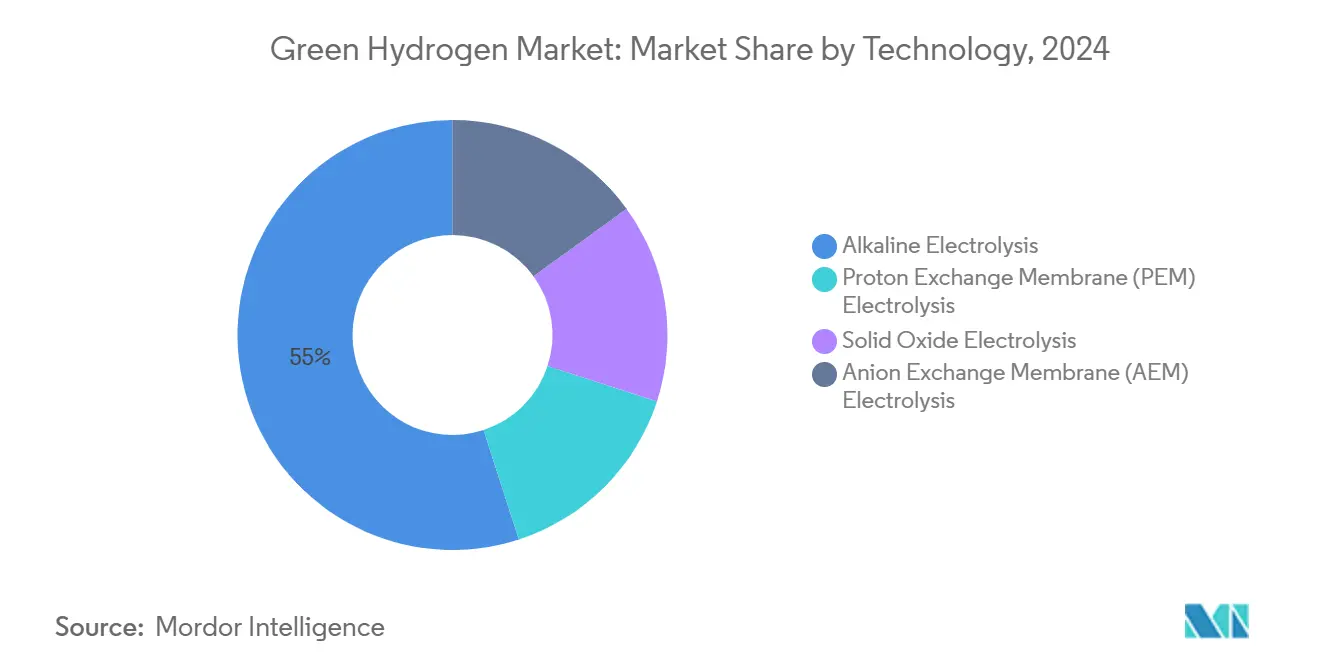
Note: Segment shares of all individual segments available upon report purchase
By End-User Industry: Refining Leads While Chemicals Surge
Refineries accounted for 35% of the green hydrogen market size in 2025 as hydrodesulfurization and hydrocracking rely heavily on high-purity hydrogen. Integration is straightforward because existing SMR-based hydrogen units can be retrofitted or gradually replaced, offering immediate scope-1 emissions savings. Long-term offtake agreements, such as the 70,000-ton annual supply deal between TotalEnergies and Air Products, illustrate how refiners secure volume and price certainty[3]Air Liquide, “Air Liquide Announces Major Investments to Support European Decarbonization Collaboration with TotalEnergies,” airliquide.com. These contracts often couple renewable-power sourcing to meet emerging fuel-carbon standards, reinforcing baseline demand within the green hydrogen market.
Chemicals represent the fastest-growing segment, accelerating at 47.18% CAGR as green ammonia and methanol capacity advances from pilot to commercial scale. Fertilizer makers see hydrogen derivatives as compliance tools for evolving EU and North American product-carbon disclosures, while methanol producers target marine-fuel applications that carry price premiums under forthcoming IMO rules. Iron and steel projects based on hydrogen direct-reduced iron are also progressing; once initial setups prove technical viability, follow-on orders could command double-digit shares of future electrolyzer shipments. In transportation, national mobility plans in Japan and South Korea underpin station build-outs that rely on predictable green hydrogen supply, turning mobility demand into another structural leg of the green hydrogen market.
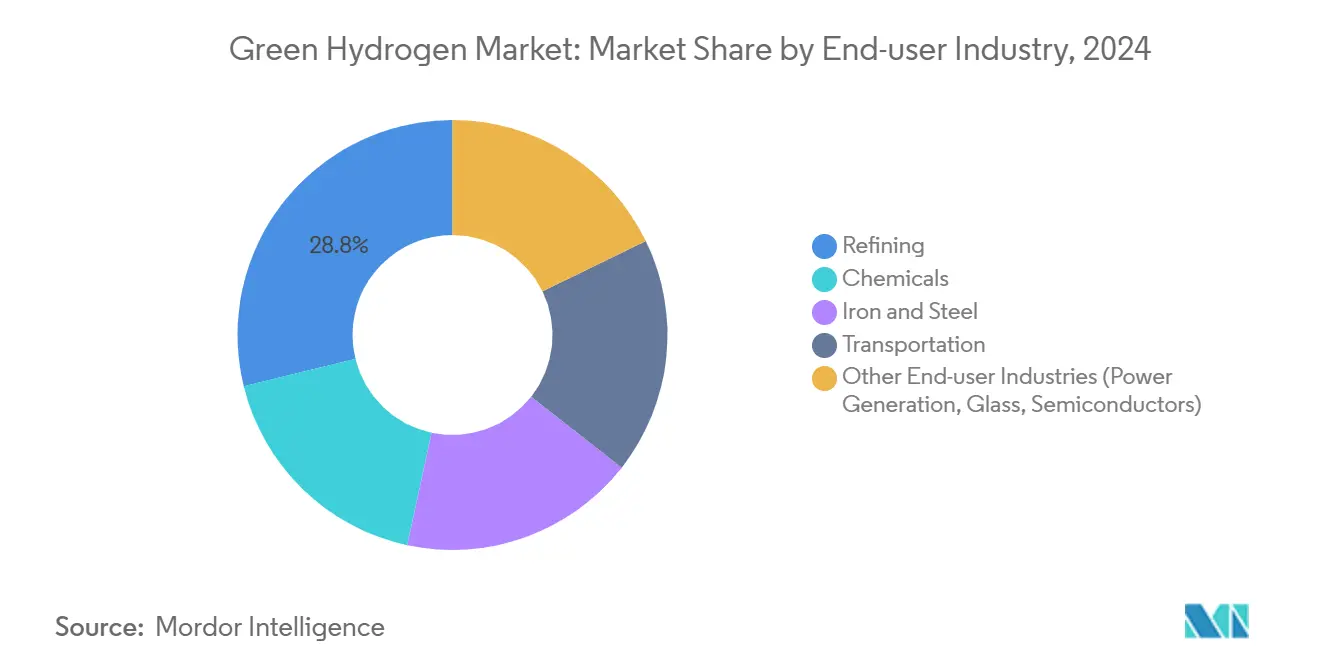
Note: Segment shares of all individual segments available upon report purchase
Geography Analysis
Asia Pacific led the green hydrogen market with a 48% share in 2025, benefiting from cost-competitive solar manufacturing, large domestic energy demand, and active policy frameworks. China, with its dominant electrolyzer fabrication capacity, exports alkaline systems at lower prices compared to their European counterparts, a price gap that significantly influences global project economics. India’s National Green Hydrogen Mission targets 5 million tonnes of annual output by 2030, supported by USD 88 billion in planned investments that include tax incentives and grid-fee exemptions. Japan and South Korea prioritize import logistics, chartering carrier vessels and reserving port space for liquid-hydrogen or ammonia unloading, positioning the region for integrated supply chains across the green hydrogen market.
Europe is the fastest-growing region in green hydrogen market, advancing at a 54.17% CAGR and backed by more than EUR 5 billion in direct public funding. Member states are streamlining permitting via one-stop-shop agencies and auctioning contracts for differences that bridge the cost gap between gray and green molecules. Spain aims for 11 GW of installed electrolyzers by 2030, leveraging relatively low solar-generation costs and proximity to maritime export routes. Germany’s GET H2 Nukleus pipeline supports industrial clusters in Lower Saxony, while the Netherlands accelerates offshore wind-to-hydrogen hubs in the North Sea. Regulatory clarity and coordinated infrastructure plans strengthen investor confidence, ensuring that Europe sustains its momentum in the green hydrogen market.
North America, South America, and the Middle East add complementary growth vectors. The United States offers production tax credits under the Inflation Reduction Act worth up to USD 3/kg, enhancing project bankability across the Gulf Coast and Midwest corridors. Brazil’s onshore wind and solar resources can produce more than 2 million tons of green hydrogen annually; coastal ports in Ceará and Pernambuco already host FEED studies for export terminals. Saudi Arabia’s NEOM development combines 4 GW of renewables with 2.2 GW of electrolyzers, targeting ammonia exports to Europe and Asia. While water scarcity necessitates desalination, abundant land and insolation underpin cost leadership. Collectively, these initiatives round out a globally diversified growth map that reinforces green hydrogen market growth across key regions.
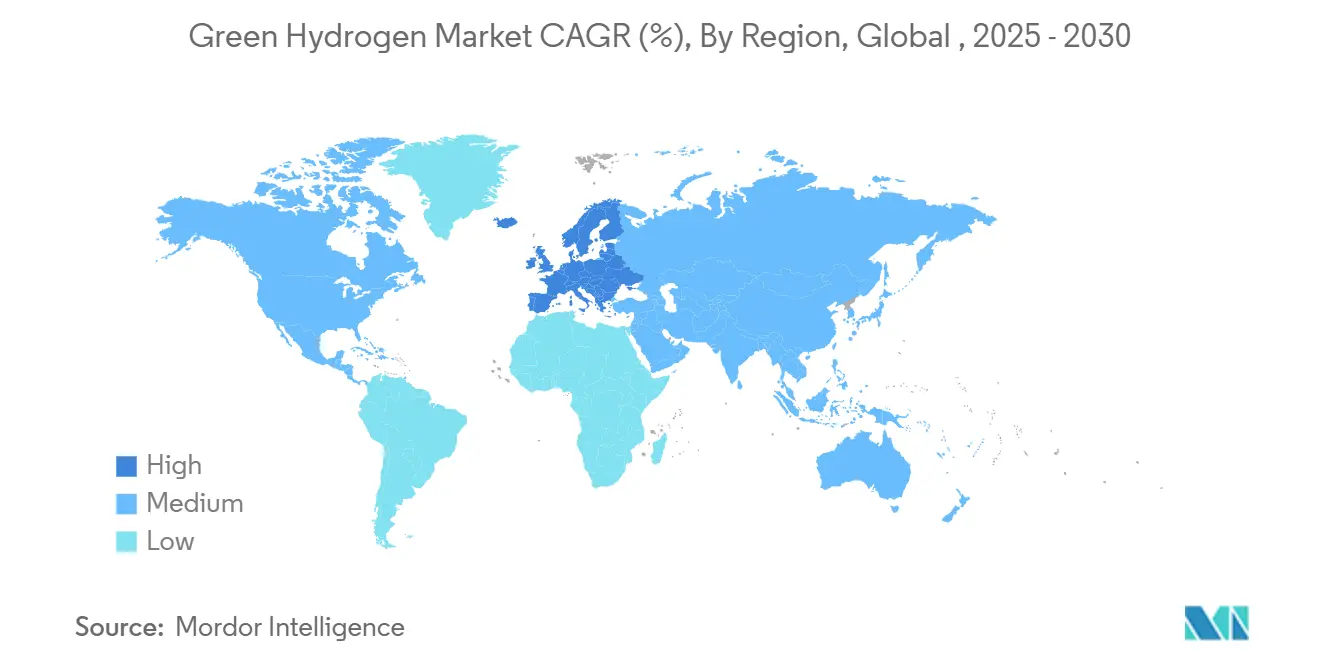
Competitive Landscape
The green hydrogen market is structured into four tiers: industrial-gas majors, electrolyzer specialists, renewable-asset owners, and energy multinationals. Companies like Air Liquide, Linde, and Air Products secure large EPC contracts by leveraging gas-handling expertise and bundling offtake guarantees. Emerging niches include high-purity hydrogen for semiconductors and hydrogen storage for grid balancing. Innovators like Enapter advance low-cost Anion Exchange Membrane technologies, challenging alkaline incumbents.
Green Hydrogen Industry Leaders
Air Liquide
Air Products and Chemicals Inc.
BP PLC
China Petroleum & Chemical Corporation (Sinopec)
Linde PLC
- *Disclaimer: Major Players sorted in no particular order
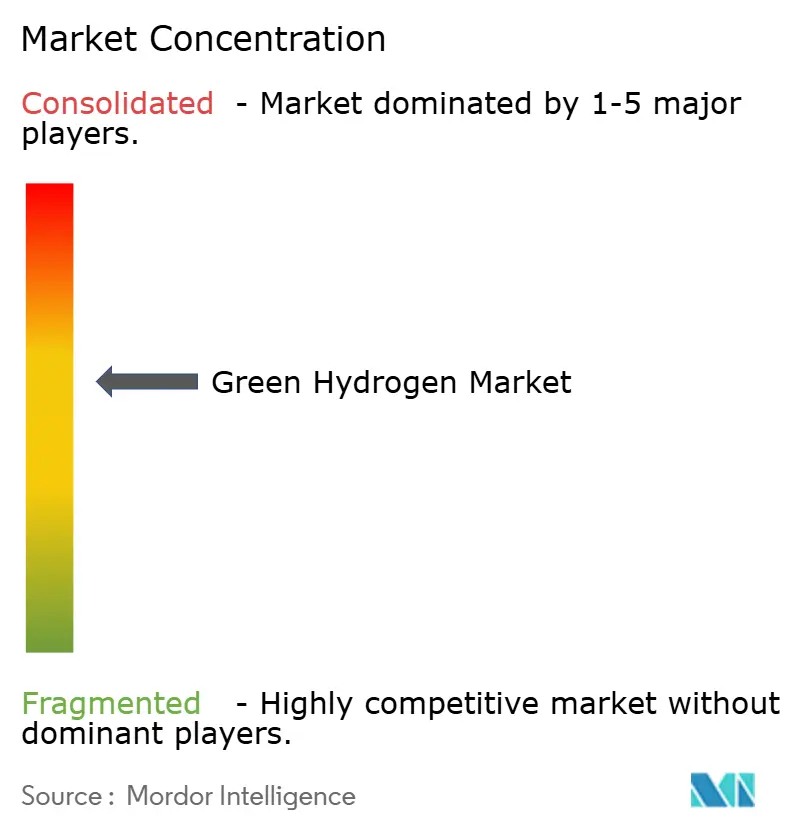
Recent Industry Developments
- February 2025: Air Liquide launched two electrolyzer projects in Rotterdam and Zeeland, totalling 450 MW and EUR 1 billion (~USD 1.14 billion) in investment, aiming to avoid 500,000 tonnes of CO₂-equivalent emissions annually.
- March 2025: ABB and Charbone Hydrogen agreed to develop up to 15 modular production facilities across North America, with the first unit in Québec slated for mid-2025 grid connection.
- January 2025: Lhyfe signed an MoU with Masdar targeting 1 million tons of annual green hydrogen output by 2030 through a 100 GW renewable portfolio.
Research Methodology Framework and Report Scope
Market Definitions and Key Coverage
Our study defines the green hydrogen market as all hydrogen generated through water electrolysis powered solely by renewable electricity, then delivered for industrial feedstock, mobility, power generation, or long-duration energy storage. Capacity is included once commercial offtake begins.
Scope Exclusions: Hydrogen derived from fossil fuels or from grid electricity that breaches accepted carbon-intensity thresholds is not part of this assessment.
Segmentation Overview
- By Technology
- Alkaline Electrolysis
- Proton Exchange Membrane (PEM) Electrolysis
- Solid Oxide Electrolysis
- Anion Exchange Membrane (AEM) Electrolysis
- By End-user Industry
- Refining
- Chemicals
- Iron and Steel
- Transportation
- Other End-user Industries (Power Generation, Glass, Semiconductors)
- By Geography
- Asia-Pacific
- China
- India
- Japan
- South Korea
- Rest of Asia-Pacific
- North America
- United States
- Canada
- Mexico
- Europe
- Germany
- United Kingdom
- France
- Italy
- Rest of Europe
- South America
- Brazil
- Argentina
- Rest of South America
- Middle East and Africa
- Saudi Arabia
- South Africa
- Rest of Middle East and Africa
- Asia-Pacific
Detailed Research Methodology and Data Validation
Desk Research
Open-source evidence anchors our work: IEA renewable statistics, Eurostat HS 2804 trade data, US DOE H2Hub filings, and Hydrogen Council dashboards show real volumes and projects. Company 10-Ks, project press releases, and news archived in Dow Jones Factiva and D&B Hoovers flesh out costs, start-up dates, and supply deals. These references are illustrative; many other public and paid sources guided data checks.
Primary Research
Mordor analysts spoke with electrolyzer manufacturers, renewable IPPs, industrial gas offtakers, and policy officers across Asia-Pacific, Europe, North America, and the Middle East. The conversations validated utilization rates, average selling prices, subsidy timing, and project commissioning schedules that desk work could not fully capture.
Market-Sizing & Forecasting
We begin with a top-down reconstruction. Renewable electricity earmarked for dedicated electrolysis is multiplied by typical capacity factors and conversion efficiencies to yield hydrogen output by country. Bottom-up roll-ups of announced plants (nameplate × realistic ramp-up) and sampled ASP benchmarks adjust totals where gaps appear. Key inputs include renewable PPA prices, electrolyzer capex per kW, policy incentive dollars per kg, industrial substitution targets, and learning-rate effects. A multivariate regression, stress-tested through scenario analysis, produces the five-year outlook.
Data Validation & Update Cycle
Analysts compare model outputs with trade flows, spot price series, and publicly announced offtake contracts. Anomalies trigger peer review before sign-off. Reports refresh annually, with interim updates issued after material market events.
Why Our Green Hydrogen Baseline Commands Reliability
Published estimates often vary because firms mix value and volume, count pipeline capacity differently, or refresh at unequal intervals.
Key gap drivers include scope breadth, whether equipment spend is booked as 'market value,' and how under-construction plants are treated.
Benchmark comparison
| Market Size | Anonymized source | Primary gap driver |
|---|---|---|
| 0.45 million tons (2025) | Mordor Intelligence | |
| USD 1.1 billion (2023) | Global Consultancy A | Blends blue projects and values revenue, not physical output |
| USD 11.86 billion (2025) | Global Consultancy B | Counts under-construction capacity and electrolyzer sales as market |
| USD 1.19 billion (2024) | Industry Journal C | Focuses on transport demand only and excludes Asian supply |
The comparison shows that Mordor's disciplined scope, transparent variables, and yearly refresh provide decision-makers with a balanced, repeatable baseline they can trust.
Key Questions Answered in the Report
How large is the green hydrogen market today, and how fast is it growing?
The market total 0.45 million tons in 2025 and is projected to reach 2.13 million tons by 2030, reflecting a 36.35% CAGR.
Which technologies dominate current electrolyzer sales?
Alkaline units hold 55% of sales due to mature manufacturing and lower capital costs, while PEM systems are expanding fastest on a 42.30% CAGR.
Which end-use sectors will drive the next wave of demand?
Refining remains the largest consumer, but chemicals, especially green ammonia and methanol, are set to record the highest growth at 47.18% CAGR through 2030.
What regions offer the strongest growth outlook?
Asia Pacific maintains the largest share at 48%, whereas Europe exhibits the fastest growth with a 54.17% CAGR, supported by comprehensive policy incentives.
What is the main supply chain challenge in the green hydrogen market?
Limited availability of platinum-group metals for PEM stacks poses a near-term bottleneck, potentially delaying capacity additions until recycling and substitution measures scale.
